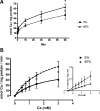The effect of dietary protein on intestinal calcium absorption in rats
- PMID: 20147526
- PMCID: PMC2840679
- DOI: 10.1210/en.2009-0744
The effect of dietary protein on intestinal calcium absorption in rats
Abstract
Increasing dietary protein intake in humans acutely increases urinary calcium. Isotopic absorption studies have indicated that, at least in the short term, this is primarily due to increased intestinal Ca absorption. To explore the mechanisms underlying dietary protein's effect on intestinal Ca absorption, female Sprague Dawley rats were fed a control (20%), low (5%), or high (40%) protein diet for 7 d, and Ca balance was measured during d 4-7. On d 7, duodenal mucosa was harvested and brush border membrane vesicles (BBMVs) were prepared to evaluate Ca uptake. By d 7, urinary calcium was more than 2-fold higher in the 40% protein group compared with control (4.2 mg/d vs. 1.7 mg/d; P < 0.05). Rats consuming the 40% protein diet both absorbed and retained more Ca compared with the 5% protein group (absorption: 48.5% vs. 34.1% and retention: 45.8% vs. 33.7%, respectively; P < 0.01). Ca uptake was increased in BBMVs prepared from rats consuming the high-protein diet. Maximum velocity (V(max)) was higher in the BBMVs prepared from the high-protein group compared with those from the low-protein group (90 vs. 36 nmol Ca/mg protein x min, P < 0.001; 95% CI: 46-2486 and 14-55, respectively). The Michaelis Menten constant (K(m)) was unchanged (2.2 mm vs. 1.8 mm, respectively; P = 0.19). We conclude that in rats, as in humans, acute increases in protein intake result in hypercalciuria due to augmented intestinal Ca absorption. BBMV Ca uptake studies suggest that higher protein intake improves Ca absorption, at least in part, by increasing transcellular Ca uptake.
Figures


Similar articles
-
Ex vivo intestinal studies on calcium and phosphate transport in growing goats fed a reduced nitrogen diet.Br J Nutr. 2012 Aug;108(4):628-37. doi: 10.1017/S0007114511005976. Epub 2011 Dec 15. Br J Nutr. 2012. PMID: 22172141
-
Molecular cloning and characterization of a channel-like transporter mediating intestinal calcium absorption.J Biol Chem. 1999 Aug 6;274(32):22739-46. doi: 10.1074/jbc.274.32.22739. J Biol Chem. 1999. PMID: 10428857
-
Bone mineral homeostasis in spontaneously diabetic BB rats. I. Abnormal vitamin D metabolism and impaired active intestinal calcium absorption.Endocrinology. 1989 Feb;124(2):565-72. doi: 10.1210/endo-124-2-565. Endocrinology. 1989. PMID: 2536313
-
Alternative perspective on intestinal calcium absorption: proposed complementary actions of Ca(v)1.3 and TRPV6.Nutr Rev. 2011 Jul;69(7):347-70. doi: 10.1111/j.1753-4887.2011.00395.x. Epub 2011 Jun 3. Nutr Rev. 2011. PMID: 21729089 Review.
-
Calcium metabolism and correcting calcium deficiencies.Endocrinol Metab Clin North Am. 2012 Sep;41(3):527-56. doi: 10.1016/j.ecl.2012.04.019. Epub 2012 May 30. Endocrinol Metab Clin North Am. 2012. PMID: 22877428 Review.
Cited by
-
The acid-ash hypothesis revisited: a reassessment of the impact of dietary acidity on bone.J Bone Miner Metab. 2014 Sep;32(5):469-75. doi: 10.1007/s00774-014-0571-0. Epub 2014 Feb 21. J Bone Miner Metab. 2014. PMID: 24557632 Review.
-
Dietary protein in relation to bone stiffness index and fat-free mass in a population consuming relatively low protein diets.J Bone Miner Metab. 2013 Jul;31(4):433-41. doi: 10.1007/s00774-013-0427-z. Epub 2013 Feb 19. J Bone Miner Metab. 2013. PMID: 23420299
-
Supplementing a low-protein diet with dibasic amino acids increases urinary calcium excretion in young women.J Nutr. 2014 Mar;144(3):282-8. doi: 10.3945/jn.113.185009. Epub 2014 Jan 15. J Nutr. 2014. PMID: 24431325 Free PMC article. Clinical Trial.
-
The relationship between protein quantity, BMD and fractures in older adults.Ir J Med Sci. 2018 Feb;187(1):111-121. doi: 10.1007/s11845-017-1642-8. Epub 2017 Jul 3. Ir J Med Sci. 2018. PMID: 28674746 Review.
-
Expression of Tight Junction Proteins and Cadherin 17 in the Small Intestine of Young Goats Offered a Reduced N and/or Ca Diet.PLoS One. 2016 Apr 27;11(4):e0154311. doi: 10.1371/journal.pone.0154311. eCollection 2016. PLoS One. 2016. PMID: 27120348 Free PMC article.
References
-
- Kerstetter JE, O'Brien KO, Insogna KL 2003 Low protein intake: the impact on calcium and bone homeostasis in humans. J Nutr 133:855S–861S - PubMed
-
- Johnson NE, Alcantara EN, Linkswiler H 1970 Effect of level of protein intake on urinary and fecal calcium and calcium retention of young adult males. J Nutr 100:1425–1430 - PubMed
-
- Walker RM, Linkswiler HM 1972 Calcium retention in the adult human male as affected by protein intake. J Nutr 102:1297–1302 - PubMed
-
- Anand CR, Linkswiler HM 1974 Effect of protein intake on calcium balance of young men given 500 mg calcium daily. J Nutr 104:695–700 - PubMed
-
- Kerstetter JE, O'Brien KO, Caseria DM, Wall DE, Insogna KL 2005 The impact of dietary protein on calcium absorption and kinetic measures of bone turnover in women. J Clin Endocrinol Metab 90:26–31 - PubMed
Publication types
MeSH terms
Substances
Grants and funding
LinkOut - more resources
Full Text Sources
Medical

